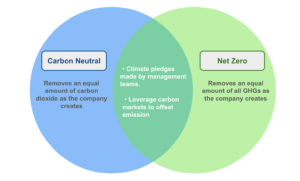A guide of Carbon Neutrality – How can it be achieved by 2050?
- CO2-reduction

Strategies to achieve substantial net zero greenhouse gas emissions, known as carbon neutrality, are gaining momentum worldwide.
This article explores the overview of carbon neutrality, its distinctions from decarbonization, the reasons for acceleration of movements, and the initiatives undertaken by various countries.
Table of Contents
- 1 What does carbon neutrality mean?
- 2 International agreements: Kyoto Protocol and Paris Agreement
- 3 Reasons for the acceleration of carbon neutrality
- 4 Transition to renewable energy – why is it important to be carbon neutrality?
- 5 How can carbon neutrality achieved by 2050?
- 6 Examples of companies’ initiatives for carbon neutrality
- 7 Actions that individuals can take to achieve carbon neutrality
What does carbon neutrality mean?

Carbon neutrality means to have a balance between emitting and absorbing carbon from the atmosphere, aiming to effectively reduce the overall emissions of greenhouse gases to zero.
Since net zero emissions is not easy to achieve, carbon offsetting or reducing greenhouse gas emission should be involved as well as balancing the equation to zero.
The main objective is greenhouse gas reduction, therefore, the world should combine initiatives such as afforestation and forest management to enhance CO2 absorption to accomplish.
Carbon neutral vs net zero
 “Carbon Neutral” and “Net Zero” are not exactly the same. While carbon neutrality focuses on balancing emissions, net zero extends the commitment to actively reducing emissions.
“Carbon Neutral” and “Net Zero” are not exactly the same. While carbon neutrality focuses on balancing emissions, net zero extends the commitment to actively reducing emissions.
Net zero aligns with the broader global objectives outlined in agreements like the Paris Agreement, emphasizing a comprehensive and sustainable approach to mitigating climate change.
Both concepts contribute to the overarching goal of creating more sustainable and environmentally friendly future, however, net zero prioritizes to reduce carbon emission with a higher standard.
It is crucial to understand the distinctions for individuals, businesses, and nations motivated to fight against climate change and make meaningful contributions.
Even though “carbon neutral” has similar meanings as “net zero”, those have different approaches for environmental sustainability and climate change.
Difference between carbon neutrality and decarbonization
Even though carbon neutrality and decarbonization have the same vision of reducing carbon emissions to zero, they also have different approaches and final objectives.
Decarbonization focuses on achieving net zero CO2 emissions, primarily addressing concerns that emerged with environmental pollution during the 1960s.
International agreements: Kyoto Protocol and Paris Agreement
The Kyoto Protocol was the first international statement to reduce greenhouse gas emissions in 1997. The statements included a 5% reduction from 1990 levels between 2008 and 2012.
Although it caused criticisms, the protocol contributed to establish the system to manage and reduce greenhouse gas emissions country-by-country.
The Paris Agreement was concluded to keep global temperatures well in 2015.
It was a climate policy goal of limiting the temperature rising less than 2 degrees Celsius, and pursuing efforts to limit temperatures rising less than 1.5°degrees.
Since that was a more reasonable statement than the Kyoto Protocol, all nations accepted the Paris Agreement to share global goals for climate change.
Reasons for the acceleration of carbon neutrality
As concerns about global warming increase, urgent actions for the issue are required.
The rejoining of the United States to the Paris Agreement in February 2021 further fueled accelerating global efforts.
Importance of decarbonization
To Understand the imperative for decarbonization is crucial for fostering individual commitment to carbon reduction.
With global warming reaching critical levels, the pace of temperature rise has increased, leading to abnormal weather patterns and heightened awareness of the environmental crisis.
Impact of global warming
Global warming caused extreme weather in the world, so carbon neutrality is becoming one of the biggest challenges for us.
The United States experienced severe droughts, India suffered from heat waves, and Australia was flooded.
All those events indicated that urgent action for climate change is essential.
Rising sea temperatures
Global warming not only affects atmospheric temperatures but also leads to a rise in sea temperatures. Higher ocean temperatures cause extreme weather, threatening marine ecosystems and fisheries.
Ecosystem disruption due to temperature rise
Climate and rising temperatures affect ecosystems.
The IPCC‘s fourth assessment report warns that 1.5 to 2.5 degrees Celsius temperature rising accelerates risks of numbers of extinction for plants and animals.
Higher temperature increases pose a severe threat, potentially causing over 40% of species worldwide to face extinction.
Transition to renewable energy – why is it important to be carbon neutrality?

Renewable energy minimizes CO2 emissions and can be replaced as a sustainable alternative with fossil fuels.
Although Japan is currently relying on imported fossil fuels, expanding renewable energy capacity can enhance energy security and stability.
The Japanese government declared to achieve a carbon-neutral and decarbonized society by 2050 in October 2020.
Sources: Japan’s Roadmap to “Beyond-Zero” Carbon | METI Ministry of Economy, Trade and Industry
This article focuses on the actions taken by the government, and two key aspects: the energy mix and carbon pricing.
Energy mix
“Energy mix” refers to the combination of diverse power generation to supply electricity, also known as the power source composition. Thermal, nuclear, hydroelectric, and solar are four energy source options in Japan.
As Japan recognizes risks associated with relying on a single power generation method, Japan emphasizes the necessity of an energy mix. With high energy consumption but a self-sufficiency rate below 10%, Japan faces the challenge of promoting an energy mix to address its energy needs efficiently.
As of now, approximately 80% of the current electricity supply in Japan comes from thermal power generation. To achieve a balanced and achievable energy mix by 2030, the 5th Basic Energy Plan aims for “S+3E,” symbolizing Safety, Energy Security, Economic Efficiency, and Environment.
Sources: strategic_energy_plan_outline.pdf
Energy-saving measures are being advanced, and the adoption of renewable energy is actively promoted to accomplish the strategies.
Carbon pricing
Carbon pricing is a policy approach aimed at setting a price on carbon emissions to incentivize a change in behavior, mainly adopted by businesses. A notable example globally is the Emission Trading System (ETS), where companies trade CO2 emissions within specified limits.
UK, Germany, Sweden, Finland, France and more countries have utilized carbon taxes and emission trading systems for carbon pricing.
In Japan, the Green Transformation Concept was approved in February 2023, outlining a growth-oriented carbon pricing plan to transition from fossil fuels to clean energy.
Sources: What is Green Transformation? | Climate Integrate
Zero-carbon cities
“Zero-Carbon City” is the councils that commit to achieve near-zero CO2 emissions by 2050.
Sources: UNCP
As of August 2021, 444 municipalities worldwide, including 40 prefectures and 268 cities in Japan, have declared their commitment to this goal.
By declaring Zero-Carbon City status, municipalities not only contribute to regional revitalization but also receive support from the Ministry of the Environment for climate change measures and greenhouse gas emission assessments.
To Achieve Zero-Carbon Cities involves essential steps such as the mandatory introduction of renewable energy, generating new industries and employment opportunities, and stimulating economic benefits through the adoption of renewable energy.
How can carbon neutrality achieved by 2050?
1. Transition to Renewable Energy
Renewable energy sources such as solar, wind, hydro, and geothermal play a crucial role in reducing carbon emissions. Governments and private sectors must invest heavily in these technologies to phase out reliance on fossil fuels. Key actions includ:
- Increasing Renewable Energy Capacity: Building more solar farms, wind turbines, and hydroelectric plants.
- Decentralizing Energy Production: Encouraging the installation of solar panels on homes and businesses.
- Improving Energy Storage: Developing advanced battery technologies to store surplus renewable energy.
2. Enhance Energy Efficiency
Improving energy efficiency across all sectors can significantly cut down emissions. Strategies include:
- Retrofitting Buildings: Upgrading insulation, windows, and lighting systems in existing buildings.
- Promoting Smart Grids: Implementing smart grid technology to optimize energy distribution and reduce waste.
- Adopting Efficient Appliances: Encouraging the use of energy-efficient appliances and industrial equipment.
3. Electrify Transportation
The transportation sector is a major source of carbon emissions. Transitioning to electric vehicles (EVs) and other low-emission modes of transport is essential:
- Expanding EV Infrastructure: Installing more charging stations to support electric vehicles.
- Incentivizing EV Adoption: Offering subsidies and tax incentives for EV purchases.
- Promoting Public Transport: Enhancing public transportation systems to reduce the number of private vehicles on the road.
4. Implement Carbon Capture and Storage (CCS)
Carbon capture and storage (CCS) technologies can capture carbon dioxide emissions from industrial processes and store them underground:
- Investing in CCS Research: Supporting the development of more efficient and cost-effective CCS technologies.
- Building CCS Facilities: Constructing large-scale CCS plants to capture emissions from power plants and factories.
- Utilizing Captured CO2: Exploring ways to use captured carbon dioxide in industrial processes, such as in the production of synthetic fuels.
Examples of companies’ initiatives for carbon neutrality
Both global and Japanese companies have introduced strategies for decarbonization.
O’right (Taiwan): This hair care brand focuses on developing CO2-neutral products and has integrated sustainable practices into its manufacturing processes, including self-power generation and organic product lines.
The Hershey Company (USA): The Hershey Company, known as chocolate brands, has the vision to reduce carbon footprint and prevent deforestation from its own suppliers by 2030.
Murata Manufacturing Co., Ltd. (Japan): Murata introduced one of Japan’s largest carport solar panels, to contribute energy efficiency. The company emphasizes a commitment to environmental impact through energy-saving and renewable energy.
Seven & i Holdings Group (Japan): “GREEN CHALLENGE 2050,” is the strategy to achieve a carbon-neutral society by 2050 by utilizing energy-saving measures and increasing renewable energy.
Actions that individuals can take to achieve carbon neutrality
To contribute carbon neutrality, individuals can focus on the following practices:
- Conserve electricity usage.
- Utilize public transportation or bicycles.
- Cultivate plants to enhance CO2 absorption.
- Avoid wasting food to reduce energy consumption.
- Minimize waste toachieve energy savings and carbon emission reduction.
While the world is still on the way to achieve carbon neutrality, individual actions are crucial in complementing government and corporate initiatives. By implementing sustainable practices, we can contribute to creating a carbon-neutral future.
You May Also Interested in:
Everything About Carbon Credits: How They Work and their Benefits.
What dose carbon budget mean and how it help us to achieve net zero emissions?
What Does It Mean To Be Carbon Negative? Difference Between Carbon Positive and Carbon Neutrality
CONTACT US
Please feel free to contact us at anytime.
We will get back to you as soon as we
can!
Editor
OFFSEL Owned by Erevista Inc, OFFSEL is specializes in Environmental issues, especially in carbon neutrality. We primarily provide the latest information on environmental energy.



